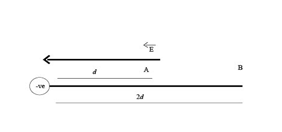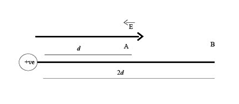1. The electric field will be to the left if the particle is negative, as indicated in the diagram below.

The potential difference is travelling from point A to point B. The potential is positive because it is in the opposite direction of the electric field. This option is incorrect.
2. The electric field will be to the right if the particle is positive, as indicated in the diagram below.

As a result, point A has a positive value, while point B has a negative value. The potential at the positive point is greater than the potential at the negative point in this scenario. So, in order for the potential difference to be positive, the potential at position A must be larger than the potential at position B , so, this option is incorrect.
3. As explained in part (2), as the particle is positive the potential at point B is less than the potential at point A
Thus, this statement (3) is correct i.e., when the particle must be positive.
4. The direction of the electric field is changed by the sign of the particle, and the sign of the potential difference is changed by the direction of the electric field.so, the statement is proved incorrect.
5. it is explained in the previous parts that the potential difference depends on the sign of the particle and the statement is not justifying it because it is saying the potential does not depend on the sign of charge which is incorrect. So, this statement is incorrect.
Thus, the correct answer is statement (3).





